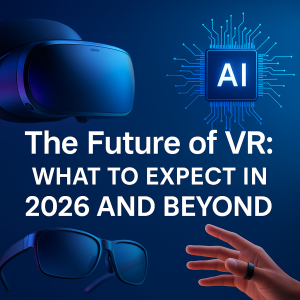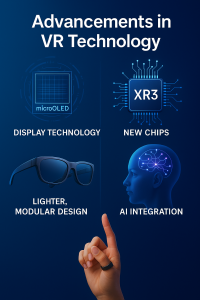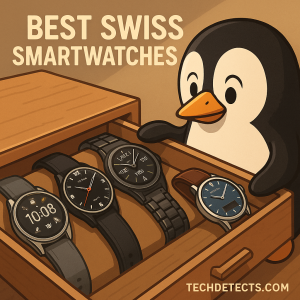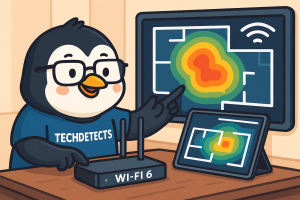The Future of VR: What to Expect in 2026 and Beyond
VR isn’t slowing down—it’s evolving faster than ever. In the next few years, advances in display tech, chips, design, AI, and input methods will reshape how we experience immersive worlds. Here’s what to watch.

Advancements in VR Technology
Display Technology: Micro-OLED, 8K, and Beyond
- Micro-OLED displays are set to become mainstream, offering richer color, deeper contrast, and sharper clarity. Meta’s 2026 prototype will reportedly use dual 0.9″ micro-OLED panels.
- Pimax Crystal Super and Dream Air promise ultra-high resolutions of 3840×3840 per eye using micro-OLED and QLED panels.
- Shiftall’s MeganeX Superlight 8K aims for lightweight VR (185g) with stunning resolution, built for extended wear.
User Impact: Expect crisp visuals, better blacks, and significantly improved legibility—especially for media, productivity, and text-heavy apps.
Next-Gen Processing Power: XR3 & Apple’s M5/M6 Chips
- Meta has pulled back on a Quest Pro 2 but continues developing next-gen devices codenamed “Pismo,” due in 2026.
- Apple Vision Pro 2 with the M5 chip is expected in late 2025 or early 2026, improving spatial AI performance.
- Long-term, Apple is prepping the Vision Air—a lighter, more affordable XR headset planned for 2027.
- Samsung’s new Galaxy XR headset, powered by Qualcomm’s Snapdragon XR2+ Gen 2 platform, debuted in October 2025 as the first Android XR device built for spatial media and productivity.
- XR pairs a vivid OLED display with optimized One UI XR software and tight integration with Galaxy phones and watches — showing Samsung’s return to the premium VR/MR space after years away.
User Impact: Smoother frame rates, smarter multitasking, lower latency, and efficient power management. Spatial apps will feel more fluid and responsive.
Glasses-Like and Modular Designs
- Meta’s “Puffin” will debut a lightweight, glasses-style MR device tethered to a compute puck—expected around 2026.
- Viture, Rokid, and Sony showcased smart glasses and modular AR prototypes with larger fields of view and slimmer frames.
- CES and AWE 2025 were filled with headsets pushing toward comfort-first design.
- Galaxy XR takes the same approach with a balanced weight distribution and a sleeker front visor than Meta Quest 3. Its modular strap system and magnetic face pads hint at Samsung’s focus on daily comfort and extended use.
User Impact: Form factor won’t be a barrier anymore. These new styles will blend into everyday use, supporting longer sessions without fatigue.
AI Integration in Spatial Interfaces
- Android XR will natively include Gemini AI, enabling spatial voice assistance, predictive gestures, and contextual awareness.
- Apple continues integrating AI in VisionOS for adaptive UIs and real-time enhancements like gaze navigation and AI content previews.
User Impact: Smart assistants will become visible and helpful—appearing only when needed, guiding your experience without intrusion.
New Input Methods: Rings, Gloves, and Eye-Driven UIs
- Gesture rings from KiWear and other startups allow natural input without bulky controllers.
- Kopin’s embedded eye tracking (NeuralDisplay) aims for minimal lag gaze interaction with no external sensors.
- Haptics and gloves are being reimagined for lightweight designs and deeper immersion.
User Impact: Gaze and gesture will dominate input. VR will feel less like using a device and more like directing an environment.
What It Means for Developers, Creators, and Consumers
- Developers must build for adaptive screens, flexible form factors, and AI-assisted UX.
- Creators will have more immersive and wearable canvases: think spatial video, volumetric visuals, and mixed-layer storytelling.
- Consumers will get focused options—headsets for gaming, daily productivity, mobile use, or rich media viewing.

Wrap-Up: Timeline for What’s Coming
| Innovation Area | Expected Timeline |
|---|---|
| Micro-OLED lightweight headsets | Late 2025 – 2026 |
| Samsung Galaxy XR (First Android XR Headset) | Late 2025 (Released) |
| Apple Vision Pro 2 (M5) | Late 2025 – Early 2026 |
| Android XR AI integration | Starting late 2025 |
| Glasses-style MR wearables | Throughout 2026 |
| Apple Vision Air (lighter) | 2027 |
Galaxy XR’s arrival kicks off the Android XR era, bridging the gap between today’s VR headsets and fully spatial devices coming in 2026.
How to Prepare: If you’re on the fence now, 2026 will be a landmark year for lighter, smarter, and more immersive VR. Waiting might mean skipping awkward compromises and jumping straight into the era of everyday-ready spatial gear.
You might want to check it out: Top VR Headsets for Gaming (PC, Console & Standalone)






